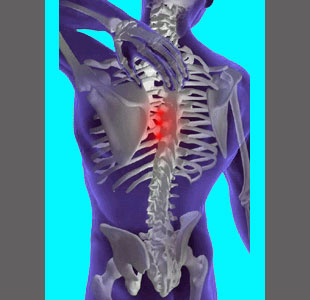
Thoracic foraminal stenosis describes a narrowing of the nerve root exit passageways that might create a compressive neuropathy condition in the upper or middle back regions. Of all varieties of neuroforaminal stenosis, narrowing in the thoracic spine is certainly the least common and least often pathological. The neuroforamen are openings through which the nerve roots leave the spine. These spaces are more than large enough to allow the nerve root to exit unimpeded, but can become smaller due to injury, degeneration and other contributing factors. When the nerve can no longer egress from the foramen without being compressed by the narrowed space, the possibility for problematic symptoms becomes bitter reality.
This essay examines the occurrence and causes of thoracic neuroforaminal narrowing, as well as the possible consequences it may entail.
Causes of Thoracic Foraminal Stenosis
Unlike the cervical and lumbar regions, the thoracic spine does not typically suffer the same marked degree of age-related changes, such as osteoarthritis and intervertebral desiccation. This spares the region from suffering significant central and foraminal stenosis in most people, for life. However, this is not to say that exceptions can’t or don’t occur. In fact, when foraminal stenosis does occur to pathological degrees, it can become a real problem, both from diagnostic and treatment points of view.
Injury is certainly the most common reason for thoracic stenosis to occur. Trauma to the middle or upper back can dispose the region towards narrowed central or neuroforaminal canals. Car accidents, significant falls, sporting injuries and other damaging occurrences can all take their toll on the thoracic anatomy.
Other patients suffer stenosis of the central or foraminal canals due to related structural abnormalities in the thoracic spine, such as scoliosis, hyperkyphosis or very rare thoracic retrolisthesis or anterolisthesis.
Very few patients will develop problematic versions of middle or upper back stenosis simply due to age. The thoracic spine simply does not suffer the same degrees of structural deterioration as the other spinal regions, but exceptions to this rule do occur.
Foraminal Stenosis in the Middle and Upper Back
Narrowed foraminal openings do not cause any problems at all unto themselves. In fact, if it were not for the exiting nerve, the space could fully close without causing any pain or symptomology. However, since a nerve must exit, symptoms might begin if and when the opening becomes narrow enough to impinge on the nerve and prevent proper signal transmission.
If the nerve is effaced or displaced slightly, symptoms are not likely to commence or remain in any noticeable form. However, if enduring compression takes place, the nerve will likely suffer the usual expression of symptoms beginning with pain and then progressing through tingling, numbness and weakness in the areas served by the distressed neurological structure.
When this condition becomes chronic, pain is unlikely to exist to significant degrees, but the affected bodily area will be objectively numb and weak, helping the diagnostician to find the definitive source of the symptomology using medical imaging to locate the stenotic blockage.
Symptoms do not always follow this universal path, since some patients suffer partial compressions or have nerves that continue to signal regardless of being fully compressed. This can lead to ongoing pain and subjective versions of paresthesia and weakness in some instances.
Thoracic Foraminal Stenosis Assistance
Since thoracic stenosis is rare, many doctors will not consider it unless a history of known upper or middle back injury exists, or unless the patient demonstrates some serious atypical structural issue in the thoracic region. This is why some thoracic foraminal narrowing victims take longer to achieve their diagnoses than patients with cervical or lumbar neural foramen stenosis. Once diagnosed, treatment can also be challenging, since most surgeons specialize in treating neuroforaminal narrowing in the neck or lower back. In fact, some surgeons only perform a handful of thoracic stenosis surgeries each year, while others perform none at all.
The good news is that postoperative recurrences of stenosis in the thoracic spine are the least common of all forms of canal narrowing conditions in the human vertebral column. Once again, this is because the thoracic region is not called upon to move in the same manner as the neck or low back, preventing the reaccumulation of age-related stenotic debris in the area. Of course, if the patient continues to express some other pathological thoracic issue, such as a significant spinal curvature, then the stenosis might return until that source problem is addressed and resolved, typically using some variety of very invasive spondylodesis procedure.
Spinal Stenosis > Neuroforaminal Stenosis > Thoracic Foraminal Stenosis





